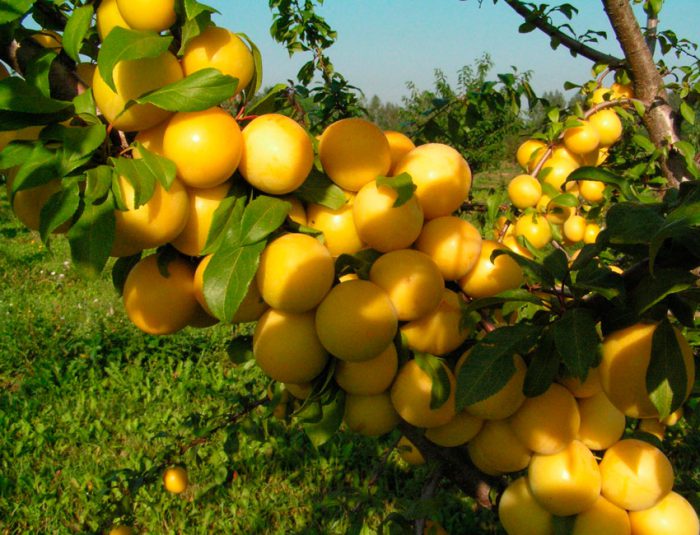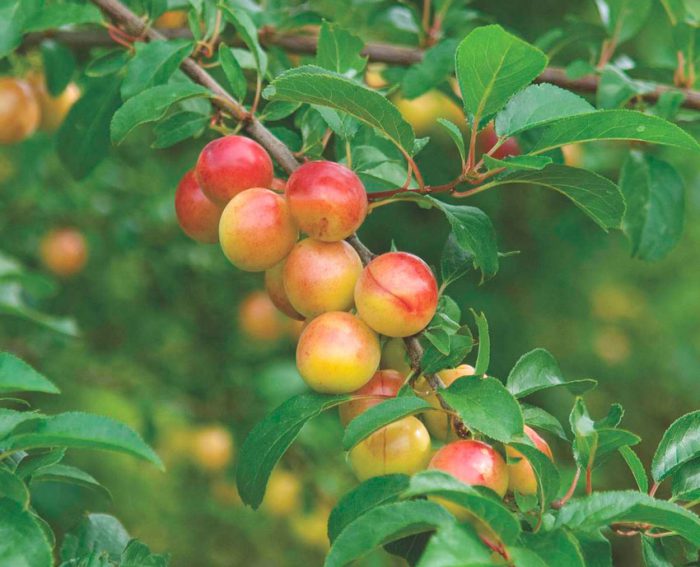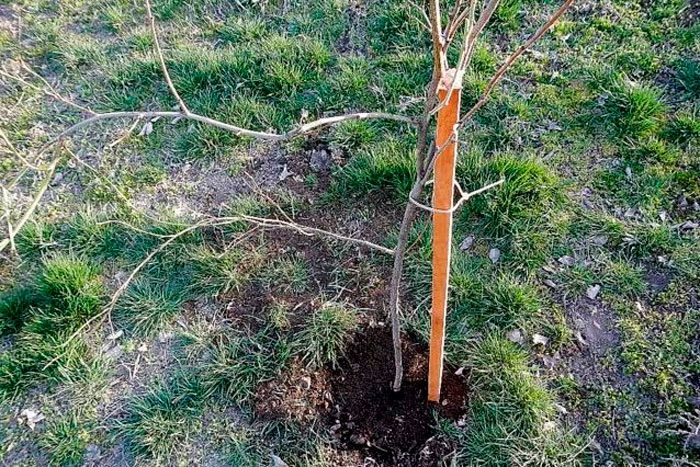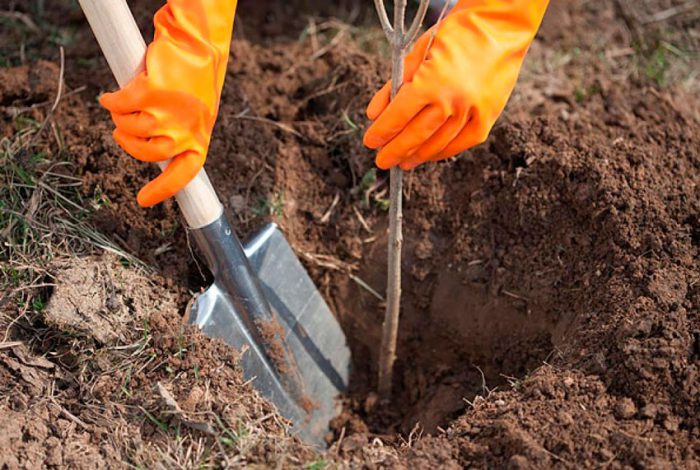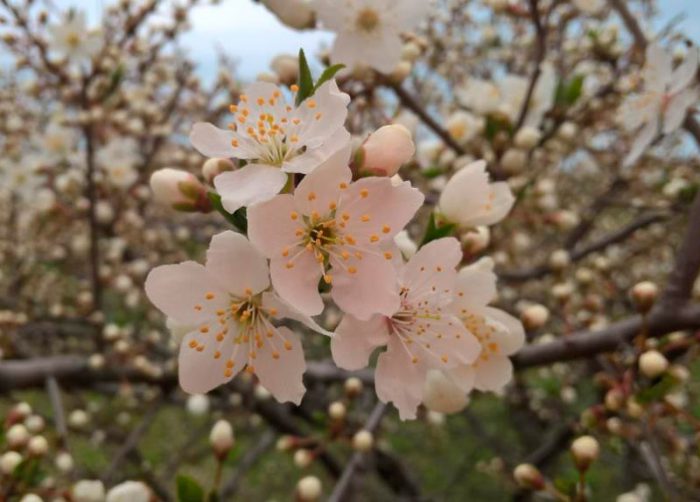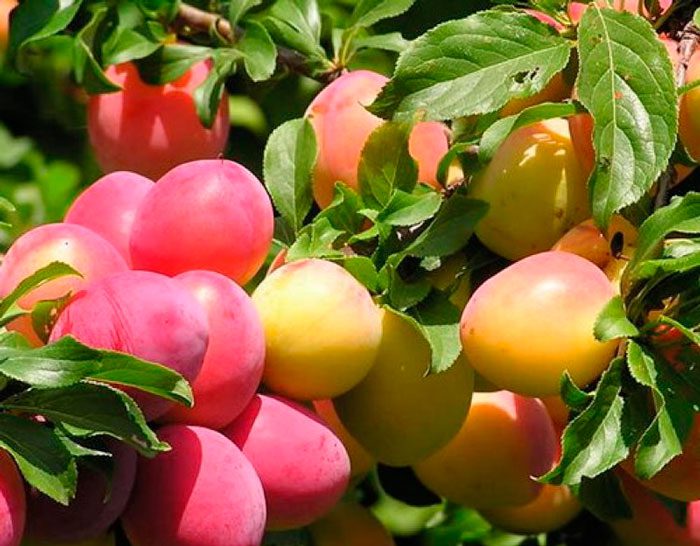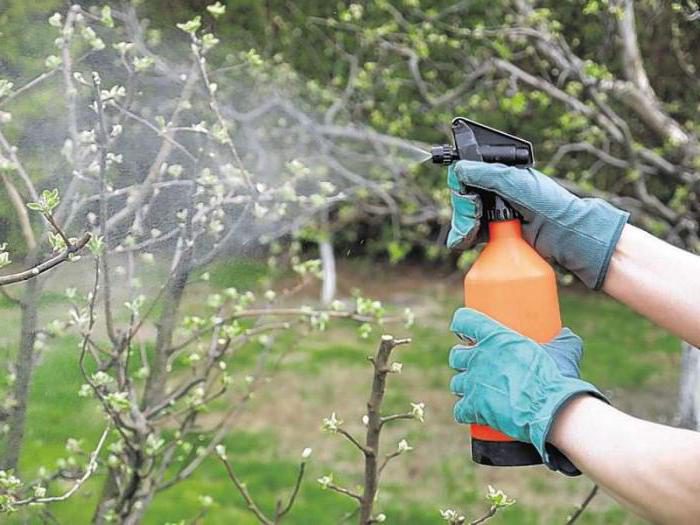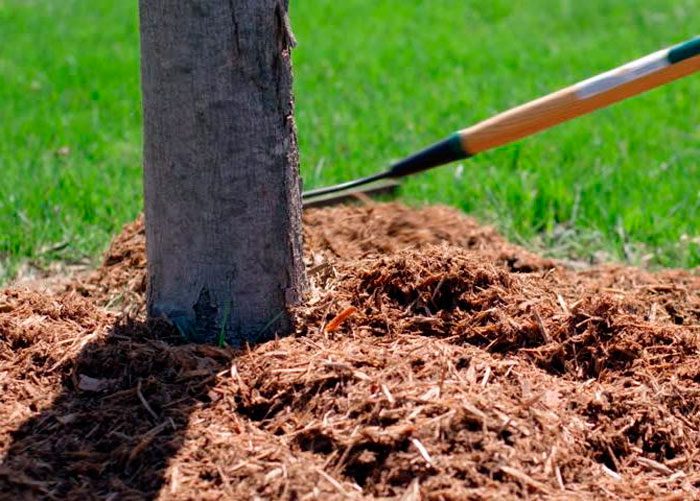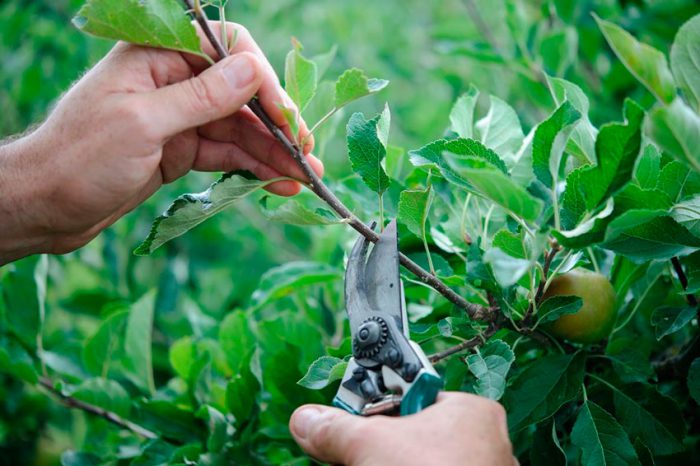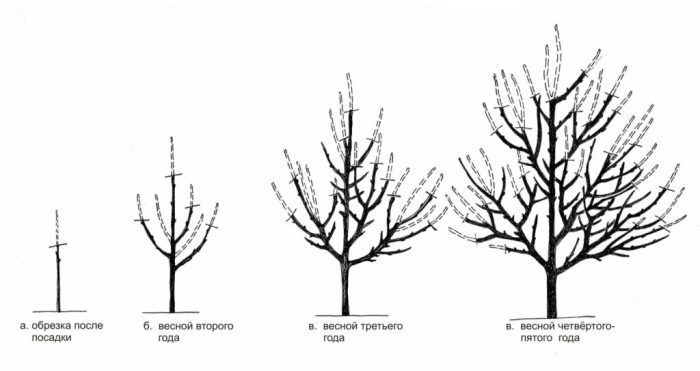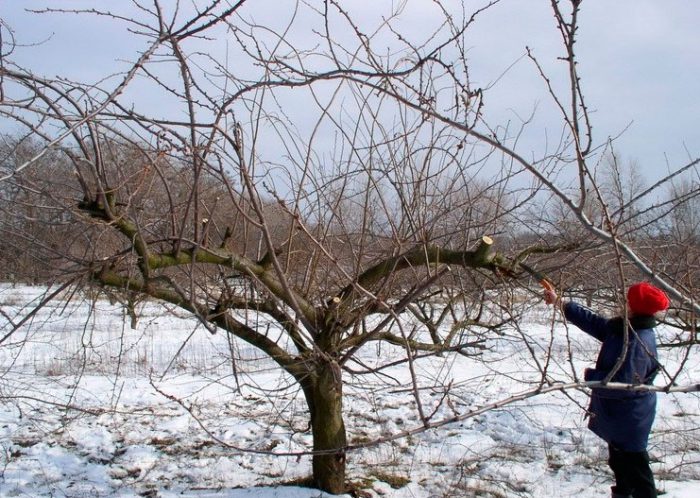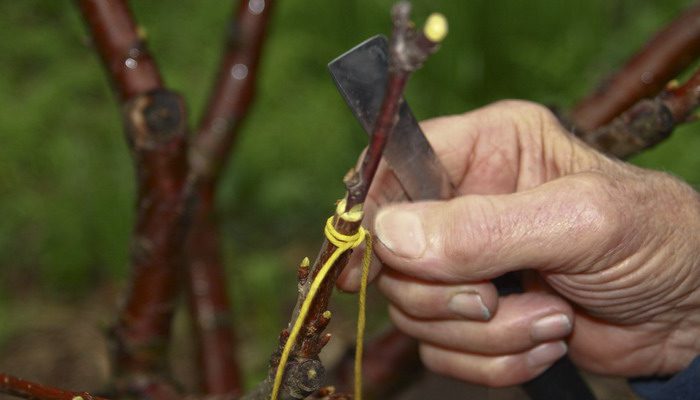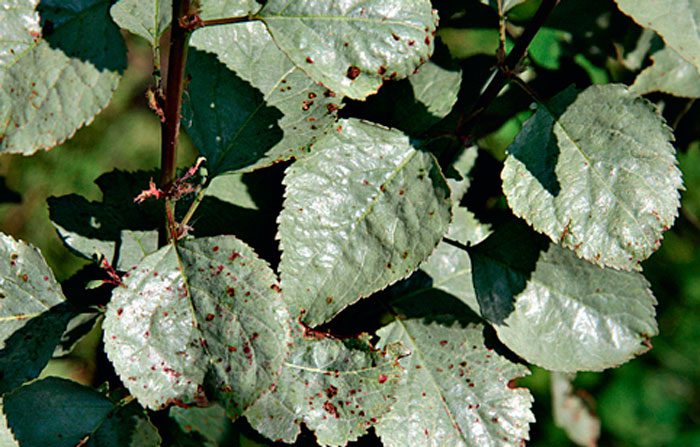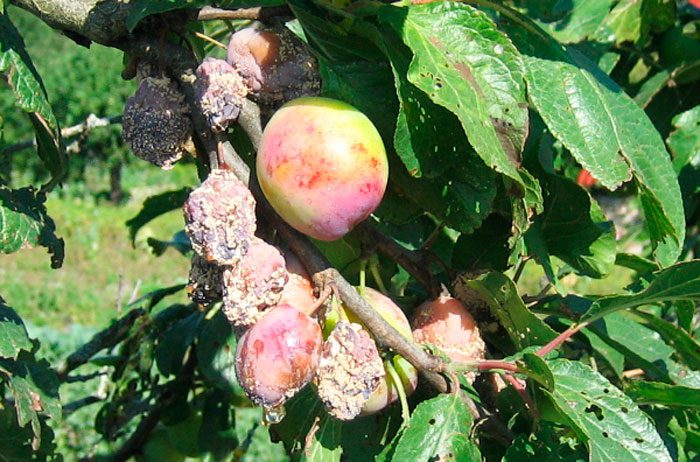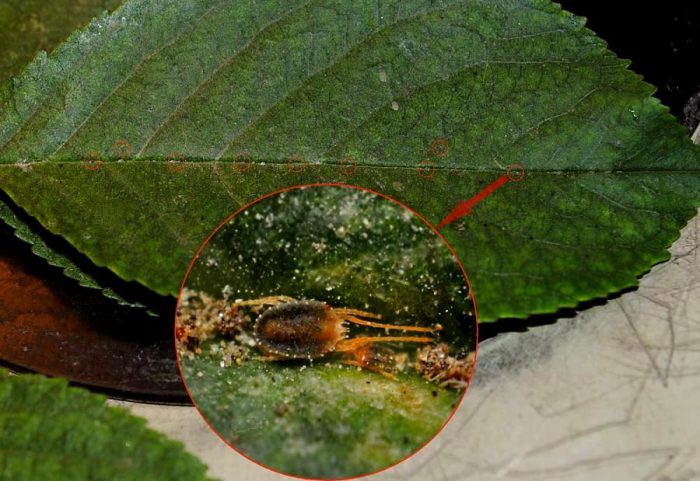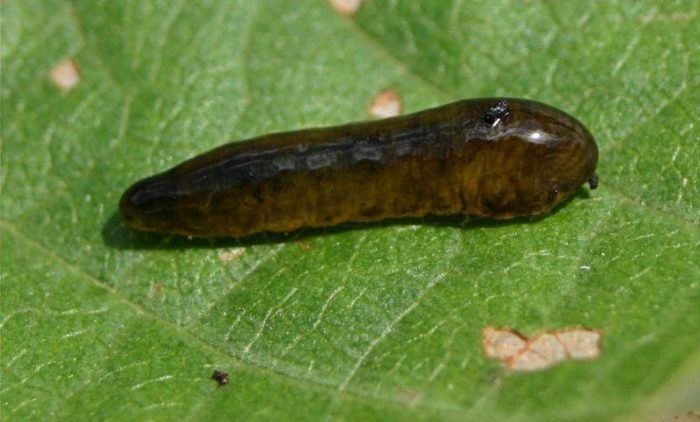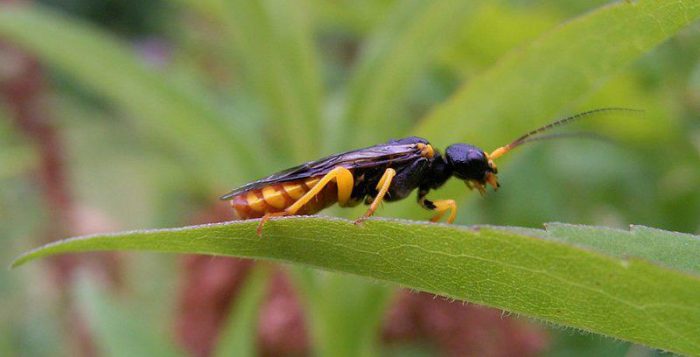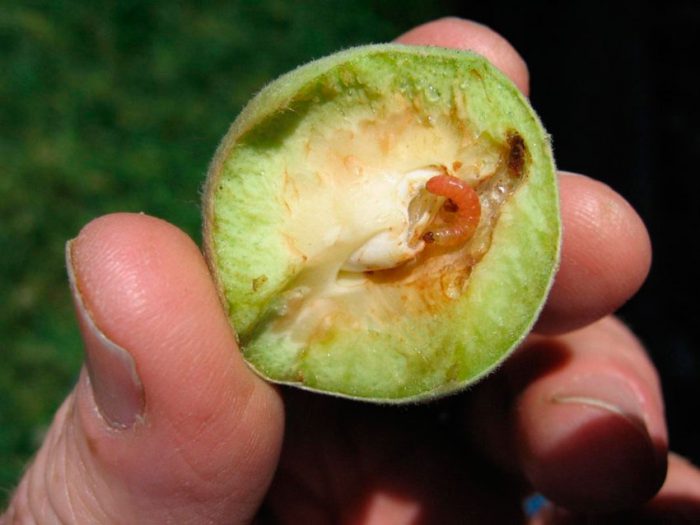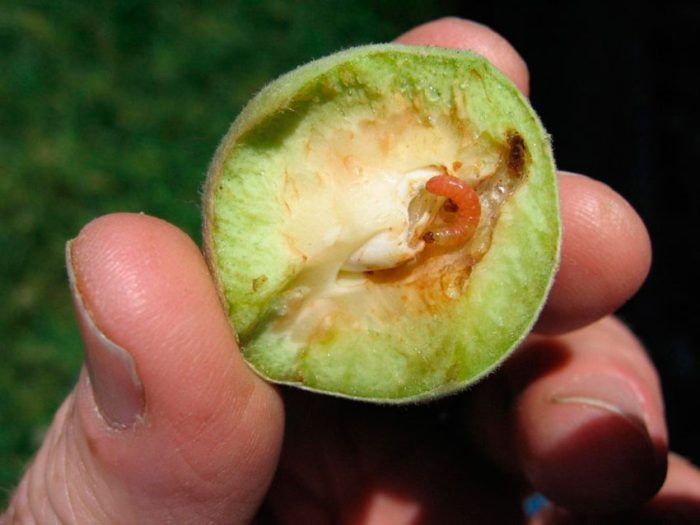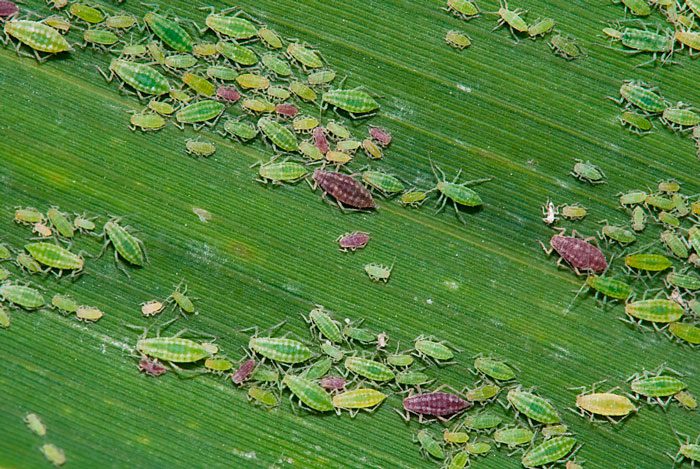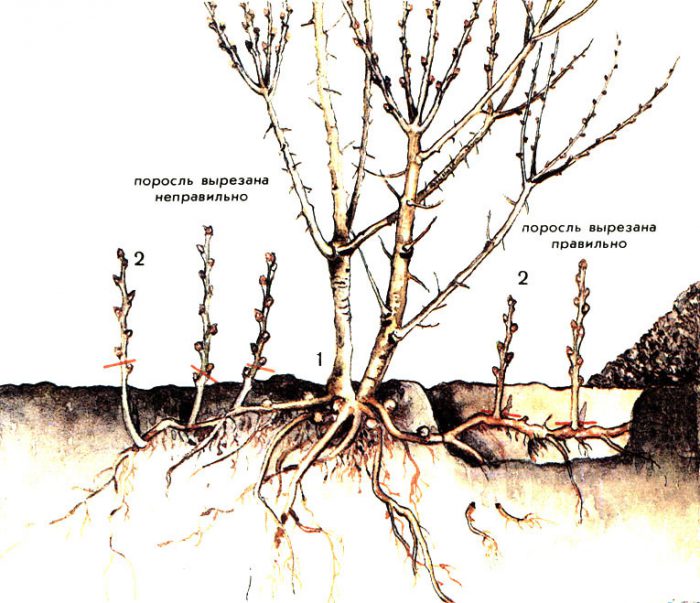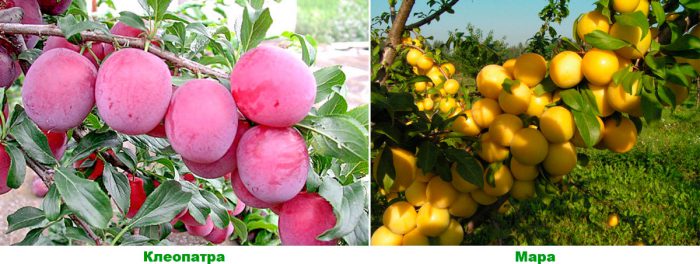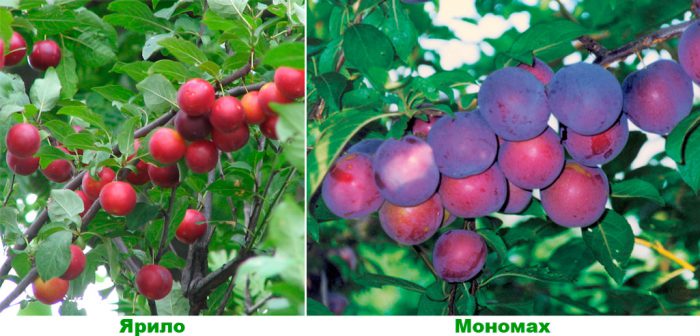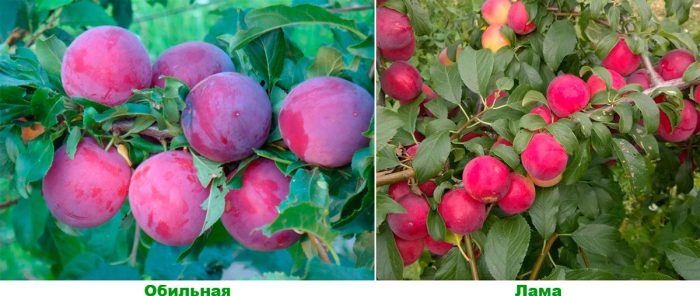Cherry plum (Prunus cerasifera) is also called cherry plum, or splayed plum, it is a representative of the genus plum of the pink family. Such a ligneous fruit plant is one of the original forms of home plum. The name of such a plant came from the Azerbaijani language, and it translates as "small plum". The motherland of cherry plum is the Transcaucasus and Western Asia. Also in the wild, it can be found in Moldova, in the Balkans and the North Caucasus, in the southern part of Ukraine, in the Tien Shan, as well as in Iran. Cherry plum is cultivated in Ukraine, Asia, Russia and Western Europe.
Content
Cherry plum features
Cherry plum is a multi-stemmed branched tree or shrub. Its height can vary from 1.5 to 10 meters. The root system is very powerful. Thin stems are colored green-brown. The shape of the leaf plates is elliptical; they are pointed towards the top. Flowers are solitary, in diameter they can reach 2-4 centimeters. They can be painted pink or white. Flowering begins in the first days of May, while the cherry plum bush covered with flowers looks like two drops of water like a plum. The fruit is a juicy round-shaped drupe, which is sometimes flattened or elongated. The length of the fruit is about 30 mm, and its color can be green, pink, almost black, yellow, red or purple, while there is a thin waxy bloom on its surface. A round or elongated bone can be flat or convex and is often difficult to separate from the pulp. The kernel contains oil, which is similar in quality to almond oil. Fruit ripening depends entirely on the plant variety and can be observed in July – September. Cherry plum can live from 30 to 50 years.
Most of the hybrids and varieties of this plant are self-fertile, which means that in order for the cherry plum to set fruit, at least two plants must be planted on the site, which will bloom at approximately the same time. If you are growing a self-fertile variety, then having a second tree nearby will increase the plant's yield and make fruiting more stable.
The relatives of cherry plum are such crops as: plum, apricot, peach, almond, apple tree, pear, rosehip, hawthorn, medlar, irga, cotoneaster, quince, mountain ash and chokeberry. This plant is distinguished by its unpretentiousness and plasticity, however, it does not enjoy much love from gardeners, unlike most of its relatives. Previously, such a culture could only be grown in a region with a warm climate. However, when it was crossed with a Chinese plum, a hybrid was born with a high frost resistance, it is called hybrid cherry plum or Russian plum. This hybrid gives a stable yield, is highly resistant to drought, diseases and pests, it begins to bear fruit 2 or 3 years earlier than cherry plum.
Planting cherry plum in open ground
What time to plant
If cherry plum is grown in a region with a warm climate, then it is recommended to plant it in open soil in the autumn. In areas with frosty winters, this is best done in the spring. Experts advise purchasing annual seedlings grown in the region where you live. If the root system of a plant is open, then planting it in open soil should be done as soon as possible. If the seedling grows in a container, then you can take your time with its transplant.
An area suitable for planting should be well lit and well protected from cold winds. The sloping slope of the western, northern and north-western exposure is very suitable for this. If the cherry plum is planted on the south side of the building, so that it is protected from gusts of cold wind, then its fruits will be very sweet and large, and this will also have a positive effect on the yield. Cherry plum grows best on nutritious loam. The root system of this plant is located, as a rule, at a depth of 0.3–0.4 m, in this regard, for planting it should be selected such areas, the occurrence of groundwater in which is noted at a depth of at least 100 centimeters.
Autumn planting
The pit should be prepared 7-15 days before planting in the last days of September. Its depth should be 0.4–0.6 m, and its diameter should be 0.6–1 m. The dug hole should be filled 2/3 with soil mixture, 1 kilogram of Nitrofoski and 15–20 kilograms of humus. Gypsum must be added to alkaline soil, and chalk, dolomite flour or lime to sour soil. In addition, a small amount of sod land should be poured into the sandy soil, and a little sand and peat into the clayey soil. In the event that several seedlings are planted, then a distance of 2 to 4 meters must be kept between them, its value depends on how large the crown of an adult plant of your chosen variety will be.
Immediately before planting the cherry plum at the bottom of the pit, it is necessary to make a small mound of earth mixture. Before planting, the root system of the seedling must be immersed for a while in a clay mash mixed with an agent that stimulates root growth (Heteroauxin). Then the seedling must be placed in a planting hole, which is filled with an earth mixture. It should be noted that the root collar of the planted grafted seedling should be at ground level. If the planted seedling is own-rooted, then its root collar can be slightly buried in the soil.
The planted plant needs abundant watering. When the water is completely absorbed by the soil, its surface will need to be covered with a layer of mulch.
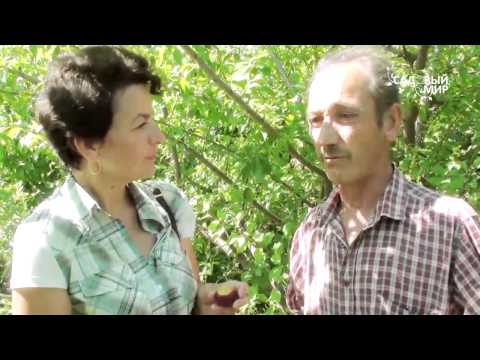

Watch this video on YouTube
Spring planting
It is recommended to prepare a pit for cherry plum in the autumn. To do this, it is dug up and covered with earth mixture. The fact is that the spring planting of such a seedling is carried out before the sap flow begins.
To plant successfully, you need to properly prepare the seedlings. If they have a closed root system, then they should be watered abundantly before removing from the container. If the cherry plum has an open root system, then cut out all the dried and rotten roots, and then immerse it in water for 24 hours. During this time, the roots should swell well. Immediately before planting, the open roots of the plant must be immersed in a clay mash mixed with an agent that stimulates their growth. Further actions during the spring planting of cherry plum should be exactly the same as in the autumn process.
Cherry plum care
How to groom in spring
If a lot of snow fell in winter, then in the last days of March or the first - April, it will be necessary to make grooves in the ground so that the melt water does not stagnate on the site. All dead bark must be removed from the surface of the trunk and skeletal branches, and then they are washed with a solution of copper sulfate (3%). Caring for cherry plum in April includes formative and sanitary pruning, planting seedlings, treatment in order to prevent various diseases and pests, grafting cuttings, digging up the soil around the plant, feeding with nitrogen-containing fertilizer, as well as cutting out root shoots.
If the winter period turned out to be with little snow, and the spring period was without rain, then the cherry plum would need spring water-charging watering. After a little time, the plant should be sprayed over the buds, and for this, a solution of trace elements is used.
Sometimes in May you have to deal with the protection of cherry plum from recurrent night frosts. In the same month, fertilizing is carried out with a complex mineral fertilizer.
How to care in summer
In summer, such a tree needs to be watered systematically. After this procedure, the surface of the trunk circle is loosened to a depth of 8 to 12 centimeters, while it will be necessary to pull out all the weeds. When watering, it should be noted that adult specimens need less water than young ones.
It is necessary to treat the plant in a timely manner from diseases and pests. Also, do not forget to pinch the ends of the shoots that do not have time to ripen before the end of the growing season.
In the event that it is assumed that there will be a lot of fruits, then set the backwaters in advance. When after the first foliar feeding of the tree 4 weeks have passed, this procedure will have to be repeated again, but now the nutrient mixture should contain not only trace elements, but also potassium with phosphorus.
If the plant is already bearing fruit, then in August it will need special care. The fact is that it is at this time that it feeds its fruits, and generative buds are laid for the next year. This month, the plant needs to weed well and loosen the surface of the trunk circle, while watering, try to get the soil wet to the depth of the root system. Fertilize with organic fertilizer, for this use a solution of bird droppings in a ratio of 1:20 or mullein (70–80 liters of water are taken for 10 liters of the substance). Organic, if desired, can be replaced with potassium-phosphorus mineral fertilizer.
How to care for the fall
After the entire crop is harvested at the end of September, and the foliage begins to change its color to yellow, mineral and organic fertilizers must be added to the soil for digging. Before the leaf fall becomes massive, the plant will need water-charging irrigation, while the soil should get wet by 0.4-0.6 m. this time, the top layer of the soil should not freeze yet.
When the planting of seedlings is over, we must begin to prepare the cherry plum for winter. First you need to clean the bark from particles that have died out, and then you should whitewash the stem and the base of the skeletal branches with lime. Next, you need to seal the existing hollows and cut out all the root growth. Fallen leaves and other plant residues should be removed from the site and destroyed.
Cherry plum processing
In April, for preventive purposes, the tree should be treated with a solution of ferrous sulfate (2%) and copper sulfate (1%), this will help protect it from viral, fungal and bacterial diseases, as well as from pests. But you can spray the plant only before the start of sap flow, otherwise the buds that have begun to open may burn out. This treatment should be repeated in the autumn, when all the foliage has fallen, which will protect the cherry plum from the same problems as in the spring.
How to water
Despite the fact that such a tree is resistant to drought, it must be watered. If the summer turned out to be dry, then on average it may need 3 waterings: when it blooms, when the growth of the stems stops, and when the berries turn into their intended color. Podzimny water-charging irrigation is carried out in October. In the event that the winter period turned out to be little snow, and there is no rain in the spring, the plant in May must be watered. Under each adult tree for 1 watering, 15–20 liters of water are poured for each year of life. Young plants need more frequent watering, namely 4 or 5 times per season.
Fertilizer
The introduction of organic fertilizer into the near-stem circle of the plant is carried out in the autumn, while 10 kilograms are taken per 1 square meter. This kind of water-charging irrigation should be done no more than 1 time in 2 or 3 years. Fertilizing with mineral fertilizers is performed every year. Before the plant blooms, in the springtime, it is necessary to apply nitrogen-containing fertilizer to the near-stem circle. In June, cherry plum needs phosphorus and potassium fertilizers. The approximate consumption rate of potassium fertilizer (potassium sulfate) - per 1 square meter from 15 to 25 grams, nitrogen (for example, urea) - from 1 to 20 grams for the same area and phosphoric (superphosphate) - from 40 to 50 grams. Also, in addition to these root dressings, the plant needs two foliar during the season. The first time the cherry plum is sprayed in May and for this a solution of trace elements is used, the second feeding is done in June, while potassium and phosphorus must be added to the same nutrient mixture.
Cherry plum wintering
If the bush is adult, then it will be able to survive the winter without shelter. And in young specimens, in the autumn, it is necessary to spud the bole very high, and cover the surface of the trunk circle with a thick layer of mulch (humus, peat or compost). You can also mulch the soil around an adult cherry plum. After the snowdrifts appear, it is recommended to huddle the trunk of the plant with snow, and you also need to cover the trunk circle to make a good snowdrift. In this case, cherry plum will be able to survive any frost.
Cherry plum pruning
Springtime is ideal for pruning cherry plum, and this is the opinion of not only amateur gardeners, but also specialists. In March or April, before the buds begin to swell, formative and sanitary pruning is performed, since in these months the plant does not yet observe strong sap flow. In the event that you are late with pruning, and the opening of the buds has already begun, then it is better to leave this procedure until the next spring period.
In some cases, pruning is also done in the summer, but it should be corrective and insignificant.
Pruning features
There are several types of pruning, namely: thinning, anti-aging, sanitary and shaping. During sanitary pruning, all unnecessary branches are removed. This pruning is done when necessary, except during the winter period.As a rule, in spring or summer, thinning pruning is performed, while all the stems and branches are cut out, which do not allow the sun's rays to fall on ripening fruits located in the thick of the crown. Formative pruning has a positive effect on the formation and ripening of fruits, and if the crown of the plant is formed correctly, this will greatly facilitate caring for it, prolong its life and strengthen its immunity. In order for the cherry plum to live longer, and its old branches were replaced by new ones, timely rejuvenating pruning is necessary.
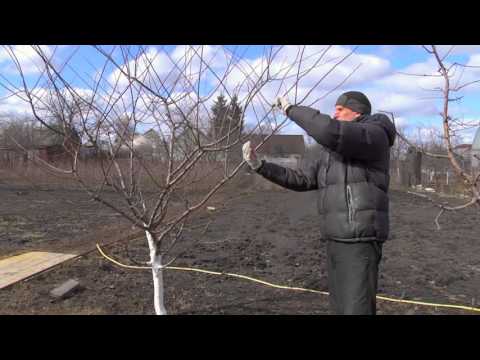

Watch this video on YouTube
Spring pruning
This plant can be shaped like a bush or tree with a bowl-shaped crown. If the winter hardiness of the variety you have chosen is not very high, then it is best to grow such a plant as a bush; for this, the seedling is trimmed at a height of 15 to 30 centimeters from the soil surface. On this segment, there should be 5 or 6 branches, which should be shortened to 50 centimeters. Using the guys, they should be spread out in a horizontal position (as far as possible). It is good to keep such bushes under a snowdrift in winter, which will exclude freezing and a long recovery period in the spring after that. Such bushes will bear fruit abundantly enough.
The stem can reach a height of 0.4–0.5 m, which will allow protecting the lower skeletal branches with snow from severe frosts in winter. However, some gardeners prefer to form a bole, the height of which reaches 0.8-1.2 m, they explain this by the fact that if the plant has a low bole, then when the snow cover begins to melt and snowdrifts begin to settle, this can lead to injury and deformation of small branches, which is why wounds can form on the cherry plum. In this regard, the gardener must independently decide what the height of the trunk will be at the tree, and here the climatic conditions of the region where cherry plum is cultivated should play a decisive role.
If such a plant is grown as a tree, then it is recommended to form a sparse-tiered crown. In this case, the crown is formed in the shape of a bowl, from 5 to 7 main branches should remain on the plant, and the remaining ones are cut into a ring. In the first year, during pruning, it is necessary that only 3 branches remain above the trunk, which should be placed along the trunk at a distance of 15 to 20 centimeters from one another, while it is necessary to choose the branches extending from the trunk at an angle of 45-60 degrees, and between they should form an angle of approximately 120 degrees. For another two years, it is necessary to add new branches to the existing ones, while their characteristics should be the same. After 2 or 3 years, the crown should already be fully formed and the tip of the conductor should be trimmed flush with the third skeletal branch.
In the last days of March, or in the first days of April, formative pruning is carried out for young specimens, while adult trees need thinning and sanitary pruning. To do this, you need to cut off all injured and dried branches and stems, and the thickening crown and annual branches should be cut into a ring. When the tree begins to bear fruit, there is a significant slowdown in the growth of its stems, and the pruning procedure will become easier.
Summer pruning
In the first 2 years of life, the branches of the cherry plum can reach 1.5–2 meters in length, so they will need to be shortened to 0.6–0.8 meters. This procedure is recommended to be carried out in the summer, since branches begin to grow vigorously in the places of the cuts. When this procedure is carried out, the development of new fruitful branches from the lateral buds will begin.
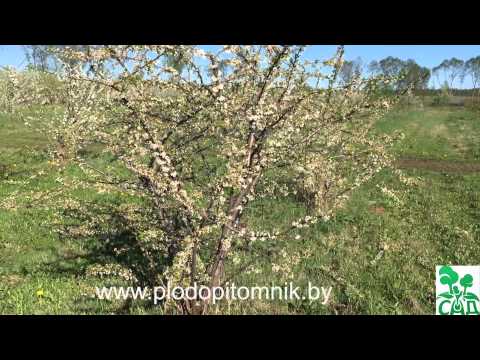

Watch this video on YouTube
Autumn pruning
Cherry plum is not pruned in the autumn, as this leads to its significant weakening before wintering.If there is such a need, then when all the leaves fall off and the tree begins to dormant, it will be possible to cut off all injured and dried stems. Places of cuts in large branches must be smeared with garden varnish.
Reproduction of cherry plum
There are several forms of cherry plum, for which the seed method is used for reproduction. However, this plant is mainly propagated vegetatively: by cuttings, root suckers and grafting. Own-rooted seedlings can be propagated by green or root cuttings, as well as by shoots. However, it should be borne in mind that for rooting green cuttings, you will need an installation capable of producing fog. In this regard, this breeding method is used only by professionals. If you grow cherry plum from a seed, then you need to be prepared for the fact that the seedling will not be able to preserve the varietal characteristics of the mother plant. It is also not recommended to grow rootstocks for cultivated forms from cherry plum seeds. For this purpose, frost-resistant rootstocks are most often used, for example, plum saplings of the following varieties: Volzhskaya krasavitsa, Vengerka Moskovskaya, Renklod kolkhozny and Eurasia 21, and you can also use saplings of apricot, blackthorn, thorny plum and felt cherry.
Reproduction of cherry plum undergrowth
Compared to other methods, the reproduction of cherry plum by shoots is considered the simplest. It is best for reproduction to choose the growth that is as far away from the parent plant as possible. The fact is that these offspring have a well-developed root system, if we compare them with the shoots growing next to the parent plant. At the beginning of the spring period, it is necessary to excavate the place where the shoots departs from the cherry plum root. After that, the parent root should be chopped off, and do not forget to retreat along it from 15 to 20 centimeters towards the mother plant. The cut should be straight. And remember that before you bury the offspring, this cut will need to be smeared with garden var.
In the event that the dug out offspring is well developed, it can be immediately planted in a permanent place. Weak and not very large shoots should be planted in loose soil, into which fertilizers are previously applied. It should be grown until it gets stronger and grows up. After that, it will be possible to transplant it to a permanent place.
Cherry plum propagation by root cuttings
Harvesting of root cuttings is carried out in early spring or in autumn; for this, the most productive plants are chosen. If the cherry plum is already an adult, then you will need to dig out its roots at a distance of 100-150 centimeters from the trunk, in young specimens this distance is 0.7-1 meter. Only those roots should be excavated whose thickness is 0.5-1.5 centimeters. Next, they are cut into cuttings, the length of which should be about 15 centimeters. In the event that the harvesting of cuttings is carried out in the autumn, they will need to be placed in a box filled with sawdust and put into a cool (from 0 to 2 degrees) room, where they will be stored until the spring period. In the first days of May, cuttings should be planted in open ground, which should be loose. The upper end of the cutting should be buried 30 mm into the ground. Moreover, its lower end must be deepened even more. Such cuttings are planted in a row, while maintaining a distance between them from 8 to 10 centimeters. The planted plants need to be covered with a film, and if it is sunny weather, then they are also covered with burlap on top. Make sure that the soil is always slightly damp. After 4 weeks, the film is removed. Before planting such cuttings in a permanent place, they will need to be grown for one or two years.
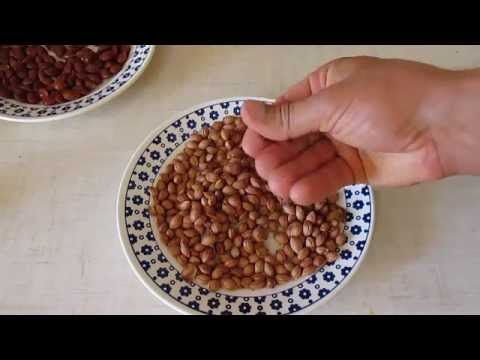

Watch this video on YouTube
Reproduction of cherry plum by grafting
Before proceeding with this method of reproduction, it is necessary to prepare a stock - a graft will be carried out on this plant, and a graft - a varietal cutting is taken. It is recommended to use seeds or shoots for growing the stock. How to grow a seedling from a root sucker is described above. To grow the stock, it is recommended to use a thorn or plum bone, which is planted in loose, moist soil in the last days of September. With the onset of the spring period, the crops should be slightly buried. The seedlings should appear in May, in the summer they will need regular watering, weeding and loosening of the soil surface. Such seedlings can be used as a stock only next summer (in July – August), at which time there is intense sap flow in the trees.
The scions are cut on the day of inoculation, while it is necessary to choose branches longer than 0.3–0.4 m. For grafting, you can choose one of the following methods: in the butt, behind the bark, in a T-shaped incision, by the method of improved copulation and twisting.
Before starting budding, the stock must be watered abundantly in order to stimulate sap flow, and using a damp sponge, it will be necessary to remove dust from the stem. All leaf plates must be cut from the scion, while the length of the remaining petiole should be half a centimeter. Then the kidney with such a petiole will need to be cut off with a very sharp knife along with a strip of bark, the length of which should be 30 millimeters, and the width - at least 5 millimeters. Above the soil level by 30–40 mm, a T-shaped incision must be made on the rootstock. At the intersection of a long and short incision, it is necessary to carefully fold back the bark, then a kidney with a strip of bark (shield) is placed under it. Then the bark should be pressed very tightly to the wood, and the grafting site should be wrapped with electrical tape or tape so that the bud with the remainder of the petiole is open.
Applied budding is often used, since this method is relatively simple and gives excellent results. The improved copulation method can be used only when the rootstock and scion are of equal thickness. The method of grafting for the bark and whipping is used when the graft is thinner than the rootstock.
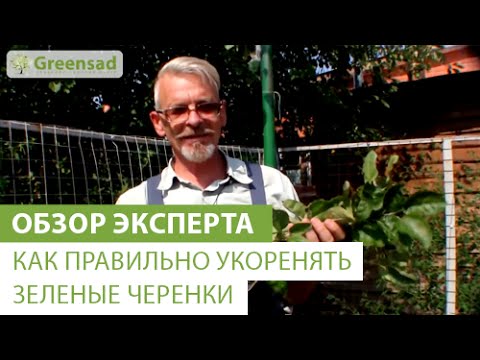

Watch this video on YouTube
Cherry plum diseases
Cherry plum can be disturbed by the same pests and diseases as its closest relative, the plum. In order to take all the necessary measures in a timely manner and save the plant, it is necessary to know the signs of each disease and a description of the pests.
Hole spot
If specks of brown color with dark edging appear on the surface of the leaf plates, then this is a symptom of a disease such as clasterosporia (perforated spot). Over time, the affected part of the leaf dies off and falls out, and a hole forms in its place. Also, small, dirty red spots form on the fruit, which causes them to deform. Light red spots also appear on the surface of the branches, cracking of the bark is observed under them, and gum begins to flow out of the cracks that appear. For prevention purposes, it is necessary to collect and burn all plant residues in the autumn. To cure the affected tree, it is necessary to process the buds with Hom or a solution of Bordeaux liquid (1%) while staining the buds. Re-processing is carried out after half a month. In the event that the damage is very serious, then you will need to spray the cherry plum 1 more time 20 days before harvesting. In spring, before the buds open, prophylactic spraying is carried out and for this, a solution of ferrous sulfate (3%) is used. It is also recommended to make thinning pruning in a timely manner, which will not allow the crown to thicken.
Milky shine
When a silvery bloom appears on the surface of the leaf plates, this indicates that the plant is damaged by a false milky sheen or milky sheen. These diseases have a different nature of origin. False milky shine, as a rule, appears as a result of freezing of a tree during wintering, and if it is well looked after, fed and watered, then after 1-3 years it should completely recover. Milky shine, in turn, is a fungal disease. It penetrates very deeply into the wood, because of which stem rot begins to develop. By the middle of summer, the leaves turn brown, and the plant itself begins to dry out. To cure a diseased tree, it is necessary to cut out and destroy all its affected parts, while the places of the cuts must be treated with a solution of copper sulfate (1%), then they are coated with garden varnish. In order to prevent such a disease in the fall and spring, you need to treat the plant with a remedy containing copper. All places of cuts and cuts must be coated with garden varnish, and the skeletal branches and stem of the plant must be painted with lime in time.
Moniliosis
Pads of gray color appear on the fruits, in which there are spores of fungi when the plant is affected by gray rot or moniliosis. Branches and stems turn brown and begin to fade as if burnt, and growths appear on the surface of the bark. From affected fruits, the disease is transmitted to healthy ones, so they need to be cut off and burned in a timely manner. It is also necessary to cut out all parts of the tree affected by moniliosis. In the spring, before the buds open, the tree should be sprayed with Bordeaux mixture (3%). Before the flowering period begins and immediately after its end, the cherry plum is treated with a drug that, in its effect on the plant, is similar to Bordeaux liquid.
Marsupial disease
Plum pockets, or marsupial disease is also a fungal disease. In the affected specimen, no seed formation occurs in the fruit. The fruit undergoes deformation, growth, and a mealy bloom forms on its surface. Infected fruit has a pale green and wrinkled flesh. Infected stems become swollen and twisted. All affected parts of the tree, including fruits, must be removed and destroyed. For the purpose of prophylaxis, the same treatment is performed as with moniliosis.
Coccomycosis
At the beginning of the summer, cherry plum can become infected with coccomycosis. In this case, small brown-red spots are formed on the front surface of the leaf plates. As the disease progresses, these spots will begin to connect with each other. A pale pink powdery coating forms on the seamy surface of the plate. Yellowed leaf plates fly around ahead of time, the fruits stop developing and dry out. For the purpose of prevention, it is necessary to collect the fallen leaves and fallen fruits in a timely manner, which are then burned. In the spring, before the sap flow begins, and in the fall, when all the foliage falls off, the tree and the surface of the trunk circle should be treated with a solution of Bordeaux liquid (1%) or Hom.


Watch this video on YouTube
Cherry plum pests
Below will be described in detail those pests that settle on cherry plum most often.
Brown fruit mite
When a brown fruit mite appears on the plant, the leaf plates change their color to brown and die off. The process of laying the future harvest is significantly slowed down. For prevention purposes, dead bark must be removed from the surface of the tree trunk in a timely manner. You will need to spray the cherry plum with Fufanon or Karate before the buds swell, during their swelling and during the period of bud formation.
Slimy sawfly
The slimy sawfly causes significant harm to the plant, it devours leaf plates, of which only veins remain.In autumn, it is imperative to remove plant residues from the site, which are then burned. In July or in the first days of August, when the larvae of the pest hatch, it is necessary to spray the plant with Novaktion or Fufanon.
Yellow plum sawfly
Caterpillars of the yellow plum sawfly are capable of causing significant harm to the plant, they eat up the bone and devour the pulp of the fruit. Ovaries can also be damaged by young larvae. Adult insects will have to be removed from the plant by hand; if desired, you can spread a film under the tree and shake them off on it. Before flowering begins, as well as after its end, the cherry plum will need to be sprayed with Novaktion or Fufanon.
Eastern moth
The eastern moth damages young shoots by gnawing holes in them. After she gets to the lignified site, she settles on a new shoot. You can find out about the presence of a moth by drying and breaking shoots. Caterpillars also pay attention to fruits, damaging their pulp. Processing is carried out twice: after the tree has faded, and when all the fruits have been collected. To do this, use a saline solution (for 1 bucket of water 0.5–0.7 kg of salt). To spray a young plant, from 1.5 to 2 liters of ready-made solution will be enough, and for an adult - about 7 liters.
Plum moth
Climbing into the fruit, the plum moth covers the entrance with pieces of pulp with cobwebs. In young fruits, such a caterpillar eats away a soft bone and all the pulp. In mature fruits, the bone is tough, and therefore does not touch it. The moves of this pest are filled with its excrement. The fruit, which has become a "house" for such a pest, changes its color to purple and falls off much ahead of schedule. In order to combat such a moth, it is recommended to collect and destroy all the flying leaves and fallen fruits, the dead bark is removed from the trunk, and the plant itself is sprayed with insecticides.
Plum aphid
Plum aphids suck out cell sap from leaf plates and young shoots of cherry plum. As a result, the leaves are deformed, turn yellow and die off. The tops of the stems also dry out. To get rid of the pest, the plant is treated with an insecticide (for example, Sumition or Karbofos) at the stage of exposing the buds. During spraying, special attention should be paid to the seamy surface of the leaf plates.
The subcortical leafworm differs in that it makes moves in the wood, this can lead to the death of individual branches and even the entire plant. Injured shoots must be pruned and destroyed. Places of cuts should be smeared with garden varnish.
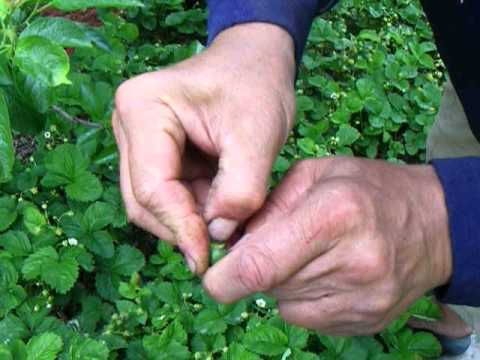

Watch this video on YouTube
Overgrowth control
Plants such as cherry, cherry plum and plum are distinguished by the presence of strong root growth. It is simply necessary to fight it, otherwise it will spread throughout the garden plot. In the event that you decide to get rid of a tree that grows overgrowth, you need to cut it down, several holes are made in the remaining stump, while trying to place them as close as possible to the sap-conducting layer. A solution of ammonium-potassium nitrate or Tornado is poured into the holes obtained. The surface of the hemp must be tightly covered with a film or a piece of plastic. After 5-7 days, you need to drill out a little these holes, into which all the same product is poured. Do the same once more after 7 days. Even after the shoots have died, you need to wait a while before removing the stump from the soil, because the agent that destroys the plant's root system must reach each root.
In the event that you want to save the cherry plum, you will have to systematically remove the root growth. Some gardeners are advised to dig up the offspring and then separate them from the mother plant, while trying to cut as close to the trunk as possible.However, experts assure that 2 or 3 new offspring will soon appear in place of such a cut instead of one. In this regard, it is necessary to cut off the offspring at the level of the ground surface. You can mow them along with the weeds. And another way out can be the cultivation of such varieties that are not able to give growth.
Cherry plum varieties with descriptions and photos
All varieties of cherry plum are divided according to ripening periods:
- early - ripening is observed in the last days of July or the first August;
- medium ripening - ripen in mid-August;
- late - ripen in the last days of August or September.
They are also divided according to plant height into undersized, medium-sized and tall. And also by the method of pollination on self-fertile and self-fertile.
Cherry plum varieties for the Moscow region
As a result of interspecific hybridization, varieties and forms appeared that can be cultivated not only in the Moscow region, but also in regions with an even more severe climate. Recommended varieties for the Moscow region:
- Nesmeyana... This early variety is relatively new, self-fertile, winter-hardy. The stone separates well from the pulp. The tree itself is spreading and tall. The flesh of pale red fruits is fibrous, dense pink in color, it is sweet and sour.
- Gold of the Scythians... This very early self-infertile variety has an average yield and a fairly high frost resistance. The height of such a plant is average, and its spreading crown is distinguished by its splendor. The yellow fruits weigh about 35 grams, their pulp is very tasty and juicy.
- Traveler... This early variety is self-fertile and resistant to frost. Small fruits, yellow with a violet-red bloom, weigh about 27 grams. The sweet pulp has an orange color, a delicate smell and a fine fiber structure. Such plants give a stable harvest, but in their fruits, the seeds are quite difficult to separate from the pulp.
- Cleopatra... This late self-infertile variety is winter hardy. Plants of medium height have a wide conical crown. Large dark purple fruits weigh about 37 grams, there is a bluish bloom on their surface. The dense red pulp is very tasty, it has a cartilaginous structure. The separation of the bone occurs only by ½ part.
- Mara... This mid-season variety was born thanks to Belarusian breeders. It is resistant to disease and frost, the plant is medium-sized. The fruit weighs about 23 grams and is yellow in color. The juicy pulp is very sweet.
Early varieties of cherry plum
The most popular early varieties:
- Found... This self-fertile variety is distinguished by its stability and yield. It is highly resistant to frost and disease. The color of the fruits is violet-red, they can be medium-sized or large, and weigh up to 31 grams. The juicy pulp has a fibrous structure and an orange color.
- Flint... The self-fertile variety is resistant to disease and drought. The dark purple fruits weigh about 29 grams and have a waxy coating on the surface. The juicy dense pulp has a red color, the stone is difficult to separate from it.
- Gift to St. Petersburg... This self-fertile variety is frost-resistant and yields stable. After receiving mechanical damage, plant recovery occurs fairly quickly. The relatively small fruits weigh about 12 grams. They are orange-yellow in color and have a slight waxy coating on the surface. The taste of juicy, rich yellow pulp is sweetish-sour, it has a fine-fiber structure. It is difficult to separate the bone from the pulp.
- Yarilo... Very early variety. Glossy, red, round, medium-sized fruits weigh about 35 grams. The dense, juicy pulp is colored yellow, very tasty, sweet and sour. The bone is separated from the pulp by ½ part.
- Monomakh... This early-growing variety is distinguished by its yield. The purple fruits weigh about 25 grams.Juicy sweet pulp has a fibrous structure and a red color. The bone is separated from it very well.
Medium varieties of cherry plum
Popular medium varieties:
- Huck... This medium-sized, self-fertile variety has a stable yield and resistance to frost. The crown is lush, flat-rounded. Large yellow fruits weigh about 35 grams. The pulp is dense, yellow, sweetish-sour. It is difficult to separate the bone from it.
- Sarmatka... A self-fertile variety that is resistant to frost and disease. The color of the medium-sized ovoid fruits is red-purple. The pulp is yellow and of medium density, sweet and sour. It is difficult to separate the bone from the pulp.
- Sigma... This frost-resistant variety has a high yield. Large yellow fruits weigh about 35 grams. The sweet-sour dense pulp has a yellow color.
- Abundant... A self-infertile variety with a high yield. On the surface of the violet-red fruits there is a waxy bloom, they weigh about 40 grams. Medium juicy firm flesh has a medium fiber structure and orange color.
- Llama... The variety is self-fertile, it stands out for its high yield and resistance to frost. The leaf plates are red. Large dark raspberry fruits weigh about 40 grams. The fragrant juicy sweet-sour pulp has a dark red color. It is very easy to separate the bone from it.
Late varieties of cherry plum
Popular late varieties:
- Late comet... The variety stands out for its very high frost resistance and high yield. The dark red fruits weigh about 30 grams. The fragrant sweet-sour flesh is red in color.
- Chuk... The self-fertile, low-growing variety has a compact crown and is distinguished by its yield and resistance to diseases. The dark burgundy fruits weigh 28 grams. The fragrant dense juicy sweet-sour pulp has an orange color. It is difficult to separate the bone from it.
- Columnar... This hybrid was created by crossing the cherry-plum Hiawatha and the large-fruited cherry plum. The plant is tall with a compact crown and frost-resistant. On the surface of the dark red fruits there is a waxy coating, they are very large and weigh about 40 grams. Juicy tasty fragrant pink pulp has an average density.
- Melon... Self-fertile, medium-sized variety is resistant to pests and diseases. There is a waxy coating on the surface of the dark red fruits, they are very large and weigh about 45 grams. The sugary medium-dense pulp has a very delicate smell, great taste and yellow color.
- Golden autumn... A frost-resistant, medium-sized variety has a spindle-shaped crown. Fruits are small golden, they weigh about 20 grams, stick to the branches even after all the leaves fall off. The flesh, yellow with an almond tint, is very tasty.
Also, gardeners are happy to grow the following hybrids and varieties of cherry plum: Apricot, Skoroplodnaya, Peach, Kuban comet, Globus, Amers, Pearl, Stenley, Olenka, Purple, Violet dessert, Anastasia, Alyonushka, Lykhny, President, Vizhen, Lyubimaya Mliyeva, Shater Karminnaya, Vetraz, Nasaloda, Pchelnikovskaya, Seedling Rocket, Krasa Orlovshchina, Timiryazevskaya, General, Ariadna, Karminnaya Zhukova, Rubinova, etc.
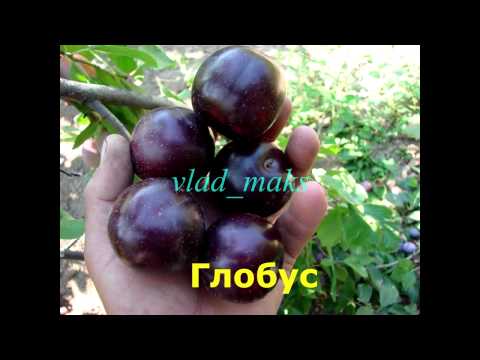

Watch this video on YouTube

